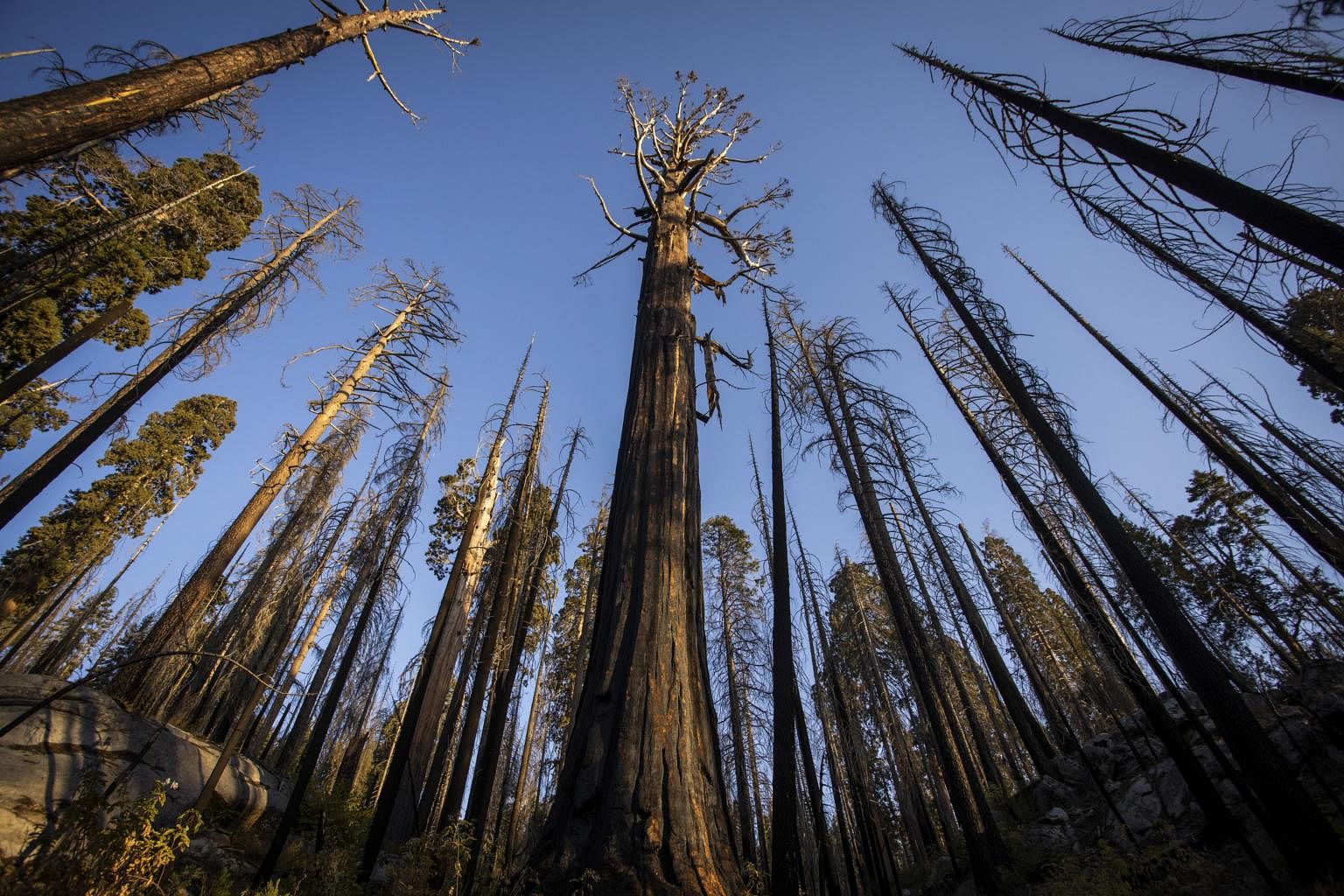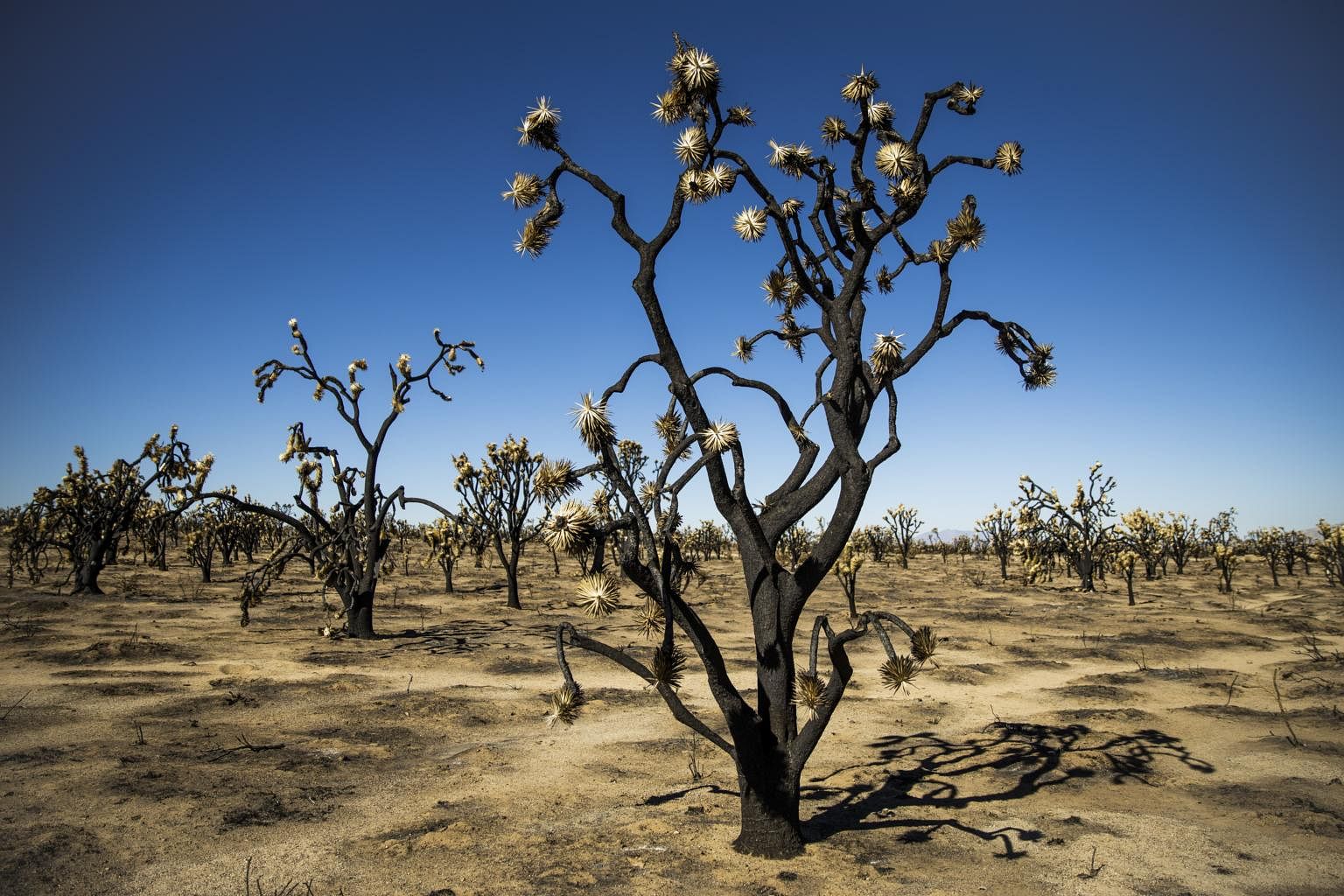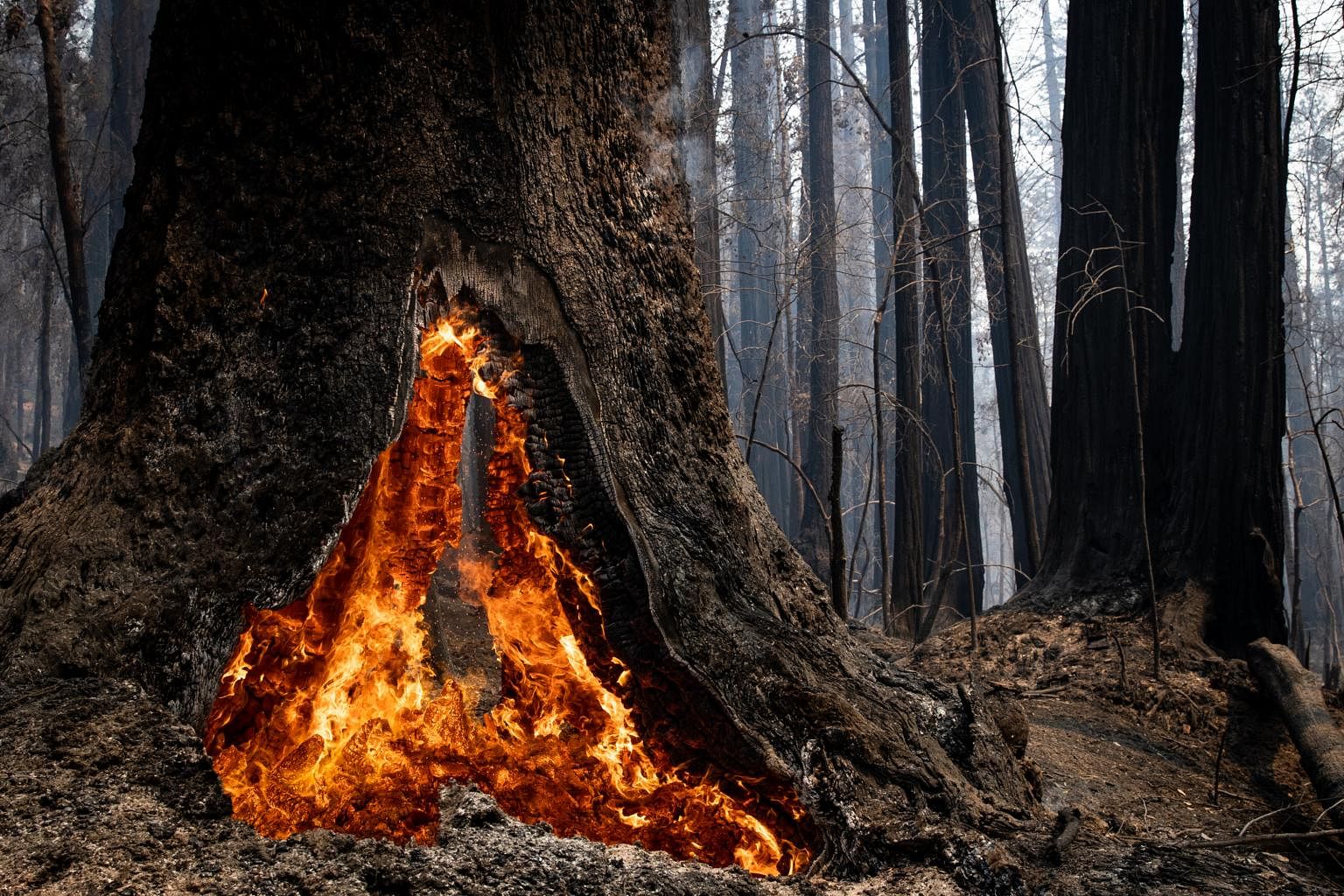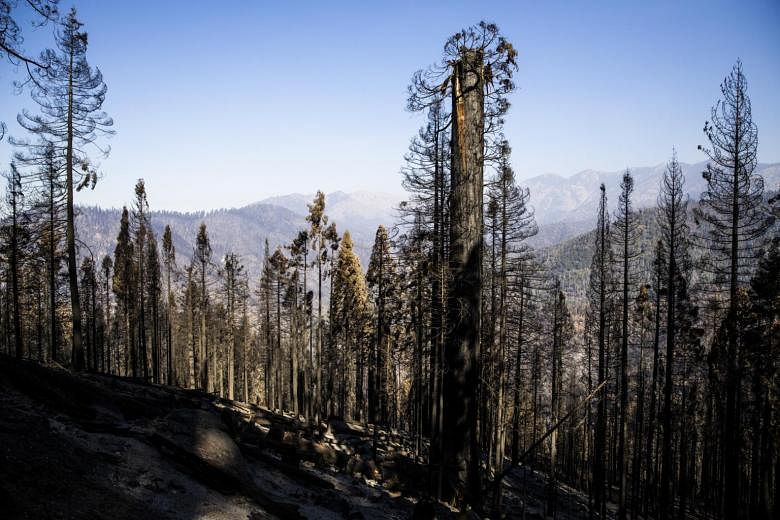NEW YORK (NYTIMES) - They are what scientists call charismatic megaflora, and there are few trees anywhere more charismatic than the three most famous species in California. People travel from around the world simply to walk among them in wonderment.
The giant sequoia. The Joshua tree. The coast redwood.
They are the three plant species in California with national parks set aside in their name, for their honor and protection.
Scientists already feared for their future. Then came 2020.
The wildfires that burned more than 4 million acres in California this year were both historic and prophetic, foreshadowing a future of more heat, more fires and more destruction. Among the victims, this year and in the years to come, are many of California's oldest and most majestic trees, already in limited supply.
In vastly different parts of the state, in unrelated ecosystems separated by hundreds of miles, scientists are drawing the same conclusion: If the past few years of wildfires were a statement about climate change, 2020 was the exclamation point.
This past summer in the Sierra Nevada, a fire ecologist named Dr Kristen Shive camped in one of the few remaining ancient groves of giant sequoias, among trees as old as the Bible. This fall she revisited the grove, and stood somberly among the dead.
"They've lived through literally hundreds of fires in their lifetimes," Dr Shive said. "Now we're seeing them killed in one fell swoop."
To the south, Mr Drew Kaiser, a botanist, hiked through what had been one of the largest remaining stands of the Joshua tree, the otherworldly yucca, in the Mojave National Preserve.
Historically, the desert is not a place prone to rampaging wildfire. But Mr Kaiser beheld a colorless moonscape dotted with the skeletal remains of collapsing Joshua trees. He estimated that 1.3 million had been destroyed in a single blaze in August.
"I love Joshua trees," Mr Kaiser said. "I can't stand to see them go."
Far to the north, near the Pacific Ocean, an environmental scientist named Ms Joanne Kerbavaz inspected old-growth redwoods, the tallest trees on Earth. She has been coming to Big Basin Redwoods State Park to roam the forests since she was a little girl.
"The smell of redwood in the summertime was the aroma of my youth," she said.
In August, fire swept through 97 per cent of the park, home of 4,400 acres of old-growth redwood trees. When Ms Kerbavaz returned in November to clamber through the destruction, all sense of timelessness and continuity had been rearranged.
"The forest I saw as a kid will not be back for some time," she said.
The enchantment that California's forests provoke can be scientific or spiritual. For the state's three famous plant species, it is probably both. The allure stems from each one's unique blend of size, shape and age. Their heft, their height, their persistence. Their sheer audacity.
They are never found together. Yet they share an uncommon ability to silently stand there and elicit a reaction - gasps, giggles, photographs, memories. How many other trees can attract a crowd?
Resiliency is key to their magnetism. They survive where others would not. They stand their ground, with panache. Sequoias and redwoods can live thousands of years on their way to dwarfing most everything around them. Joshua trees are the most good-natured of desert plants, frozen in dance poses as they endure the harshest of environments with flair.
They have a timeless quality that can make their onlookers feel small and impermanent by comparison, the way a night sky does.
That is why 2020 is particularly alarming. Each of these species already faced a rising onslaught of threats to long-term survivability, from drought to development, blanketed by the unknowable future effects of climate change.
While there is not broad concern about any of the species going extinct - yet - 2020 injected a new sense of urgency.
"The apocalyptic chickens are coming home to roost, way sooner than we thought," said Ms Christy Brigham, the resource manager at Sequoia and Kings Canyon National Parks, home to dozens of the remaining sequoia groves and the many of the biggest trees in the world. "We are seeing impacts now that we thought we would see in 50 years."
Sequoias

Until a few years ago, about the only thing that killed an old-growth giant sequoia was old age.
Not only are they the biggest of the world's trees, by volume - the General Sherman Tree, considered the largest, is 36 feet (11 metres) in diameter at its base and 275 feet tall - they are among the oldest. At least one fallen giant sequoia was estimated to have been more than 3,200 years old.
They last so long that, historically, only one or two of every thousand old-growth trees dies annually, according to Nate Stephenson, a research ecologist for the US Geological Survey.
Fire always was a frequent visitor to sequoia groves, but rarely a threat. Mature sequoias are virtually fireproof because the bark can be several feet thick. The crowns, the top where branches and needles are, are so high that they stayed above the fray of fire, out of harm's way.
Until now.
Since 2015, nearly two-thirds of the roughly 48,000 acres of giant sequoia groves have burned - about half of that since August. The amount of groves burned in the past five years is double what had burned in the previous century.
But it is not just the number of fires or acres they consume. Fires are burning bigger, hotter and higher than ever. A historic drought from 2012 to 2016 and huge infestations of bark beetles killed millions of trees in the mixed-conifer forests of the Sierra Nevada, leaving them behind as kindling.
Damage is mounting.
The starkest example in 2020 might be in Alder Creek Grove, one of 19 groves to burn this year. It is home to 483 ancient sequoias with a trunk diameter of 6 feet or more, among them the Stagg Tree, thought to be the fifth-largest in the world.
In September, the Castle Fire crept nearby, paused on a ridge, and swept through in a matter of hours.
In October, Dr Shive wandered through blackened parcels, counting dead old-growth sequoias. There were at least 80, and some areas had not yet been surveyed. Across the range of giant sequoias, this year's death toll could be in the thousands.
The Stagg Tree survived, perhaps in part because firefighters had hastily run hoses and turned on sprinklers at its base. But it will take more than sprinklers to fight off the likely destruction to come to the giant sequoias.
"They are literally irreplaceable," Shive said. "Unless you have 2,000 years to wait."
Joshua trees

Joshua trees - a yucca, not a tree, named by Mormon settlers - already teeter toward trouble. Their range is shrinking, and they are not well-suited to outrun the quickening pace of climate change. Scientists worry that future visitors will find no Joshua trees in Joshua Tree National Park, the way some worry that Glacier National Park will be devoid of year-round ice.
"It's a possibility," said Dr Todd Esque, a desert ecologist for the US Geological Survey.
Now wildfires, scarcely a threat historically, are taking out huge swaths at once, aided by climate change and invasive grasses.
The Dome Fire consumed 43,273 acres and killed most of the estimated 1.3 million Joshua trees it burned, according to Mr Kaiser, the vegetation programme manager for Mojave National Preserve.
"Cima Dome was a model for where the Joshua tree could persist for the next 100 years," Kaiser said. "It was a beautiful, lush, decadent Joshua tree forest. But they're wiped out."
While there are plans to replant the millions of dead with thousands of young Joshua trees, "It'll never come back like it was," Mr Kaiser said. "Not with climate change."
Life has a way of hiding in the desert, and a close examination revealed signs of green life poking through the sand. But a million Joshua trees will never rise again.
Redwoods

Redwoods, the tallest of Earth's trees, are the rare conifer that can resprout after catastrophic events, a secret weapon to longevity. Killing one with fire is difficult.
But it is not impossible.
Here and there, during a tour on a sunny November day, the emerald green of new growth poked out of the soil at the base of blackened trees that might otherwise be dismissed as lifeless. Some inspections required a skyward gaze to see upper branches already fuzzy with green sprouts, like Chia Pets.
Ms Kerbavaz came across one giant called "Father of the Forest".
Redwoods can live 2,000 years, and this one was black to the top. But about 200 feet up, there were signs of life.
"It's got green," she called out to those climbing through the thicket behind her. "It's not dead yet."
Still, plenty of towering trees offered no such signal. The hope is that somewhere near 90 per cent of the old-growth trees will live. But that means 10 per cent were lost.
"If anything is programmed to survive, it's the coast redwoods," Ms Kerbavaz said. "But I keep coming back to climate change. I think that's the thing that changes the ground rules significantly."
The extinction of redwoods is hard to imagine, with a cool, soggy range still measured in the millions of acres. The fear is for the relatively few remaining old-growth trees.
As Ms Kerbavaz surveyed the heart of the park recently, climbing over fallen trees and practically spelunking into smoldering stumps, the buzz of distant chain saws was punctuated by the occasional whomp of falling trees, deemed too weak to leave standing, near Highway 236, the scenic two-lane that cuts through the park.
Near the burned-out headquarters of Big Basin is a loop trail through some of the park's biggest redwoods, a path made largely impenetrable by the fallen trees.
Somehow, a sign at the trail head survived.
"The Amazing Ever-Living Redwood Tree," the sign read.
The tree behind it had burned and toppled.
"Almost fire-proof!" the sign declared.
Almost.

